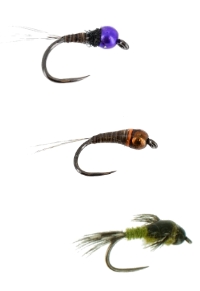Rock Creek
Starting about 20 miles west-northwest of Anaconda located in western Montana, Rock Creek is an anglers paradise. The water here runs cold and clear even during the hot summer months, making it a tremendous fishery for brown, rainbow, cutthroat, and brook trout. There are also very large bull trout that reside in the river. On occasion one of these brutes will swallow your fly or eat the trout that you have on the end of your line, putting a bend in your rod like you've never seen before. If you catch a bull trout, know that they are an endangered species and please be sure to promptly release them.
The East, Middle, Ross, and West Forks make up the headwaters of Rock Creek. Route 38 crosses the river where the forks come together to form Rock Creek. Downstream from here, Rock Creek flows for approximately 50 miles before spilling into the Clark Fork River. Along the way, boulders, logs, sharp bends and deep cuts, are a few of the characteristics that create holding water for the trout that dwell here. Big browns will also migrate into the creek during the early fall from the Clark Fork River to spawn. With long gentle riffles and wide deep pools, to swift runs with pocket water, Rock Creek really does have a variety of water. From its headwaters to where Hogback Creek empties in, the river mainly consists of soft flowing runs and riffles. Cutthroat trout are prolific in this section and account for the majority of the population. The area between Hogback Creek to Henry's Flat is where the river picks up pace and it's gradient becomes steeper. It is characterized mostly by swift riffles and deep pockets. The holding water here is generally less abundant, but yet it is a wonderful stretch of river to fish (especially if you prefer nymph fishing). Rainbows make up the majority of the fish population here, although there is a fair population of all trout species. From Henry's Flat down to its end at the Clark Fork River, Rock Creek is characterized by swift riffles, deep runs, and classic pools. Some very large brown trout are caught in this section every year.
Getting access to Rock Creek is a fairly easy thing to do. There are many places along its path to park and wade fish. Rock Creek Road follows the creek from Route 32 near its headwaters down to Route 90 where it ends at the Clark Fork River. Boats are only allowed on the river from December 1st until June 30th. From July 1st until November 30th only wade fishing is permitted.
There are a pretty wide variety of hatches that take place on this river, but mayflies, stoneflies and caddis make up most of them. Mayflies include Blue-winged Olive (baetis), Pale Morning Duns, Green Drakes, and some Brown and Gray Drakes. The two most important stonefly hatches on this river are the famed Salmon Fly and the Golden Stone hatch. Every year, these bugs bring the largest fish in the river up to feed on the surface. The Salmon Fly hatch usually occurs during the middle of runoff which usually starts sometime in early May to late June. The caddis here are made up of a variety of sizes and colors. Black, tan, and gray are excellent colors for caddis ranging in size #12-18. You can also expect to see an orange sedge hatch sometime in the fall. Midges and terrestrials fill the gaps between all this action when the other insects are not on the water.
Rock Creek is a great fishery often overlooked by many anglers. It has a wide range of water and a great population of trout that are willing to eat. Dry fly, nymph, and streamer fishing, are all productive methods on this beautiful river. Put Rock Creek high on your priority list of places to fish. Trust us, you won't be disappointed.



